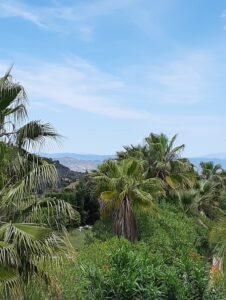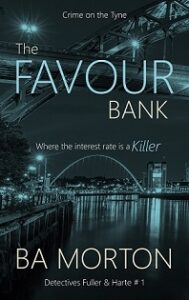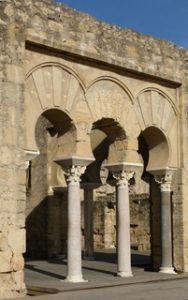
Recently, I was asked how living in Spain has influenced my writing. Thinking about it, I realised it isn’t only being in Spain that has affected my fiction, it’s all the other places I’ve lived, studied and worked in as well. Setting aside my time at an American university in what now feels like a previous existence, the cumulative effect is that I have been Latinized. I’m still old-fashioned British at heart, but with something of a Latin outlook.
 From my desk here in the Province of Málaga I can see the Sierra de Las Nieves. This was where the Moors of Al-Ándalus used to harvest snow to be collected in summer for sherbet and to keep medicines cool. To the right out of a large picture window is the bandalero country of The Empress Emerald; to the left, beyond mauve-shaded mountains, are ancient fishing villages now known as the Costa del Sol, but once prey to the Barbary corsairs featured in The Chosen Man Trilogy.
From my desk here in the Province of Málaga I can see the Sierra de Las Nieves. This was where the Moors of Al-Ándalus used to harvest snow to be collected in summer for sherbet and to keep medicines cool. To the right out of a large picture window is the bandalero country of The Empress Emerald; to the left, beyond mauve-shaded mountains, are ancient fishing villages now known as the Costa del Sol, but once prey to the Barbary corsairs featured in The Chosen Man Trilogy.
On warm days with the window open, there’s that special Mediterranean dry-earth, peppery smell described so well by Laurie Lee in his Spanish memoirs. Today, I can hear a kestrel screaming at her mate from our roof terrace. This view, as you may imagine, is very conducive to creative time travel. If I ignore a nearby road, I can be back in any century I choose.
The Empress Emerald, includes the story of Davina, a naive English girl who leaves Cornwall to live in Jerez during the 1920s. People say a debut novel is always autobiographical, this one certainly isn’t, but some scenes were developed out of my first encounter with my husband’s traditional Andaluz home. This is how I fictionalised it:
They turned a corner into a street of tall grey buildings that appeared to grow out of one another. There was no green save the painted railings of high, narrow balconies. It felt austere, grim, closed in. The driver stopped the car outside two vast doors, blackened with age and reinforced with iron. They reminded Davina of an illustration in one of her childhood picture-books, Bluebeard’s castle. As if by some sinister magic, a door swung open. Alfonso ushered her into a fern-infested patio. It smelt dank and uninviting. She looked up and around her. The patio was open to the sky, but on all four sides above there were windows. She sensed watching eyes and lowered her gaze.
Before coming to Spain I lived on the Ligurian coast of Italy – hence Ludo da Portovenere in The Chosen Man. The Genoese coastline and the Cinque Terre often crept into Ludo’s narrative – these historical thrillers could so easily have turned into travel brochures.
Portovenere, or Porto Venere, was once the site of a Roman temple to Venus: the perfect romantic location to conclude Ludo’s story in By Force of Circumstance.
It’s a tourist souvenir destination these days, but through my picture window I could easily visualise it in the 17th century.
Reviewers comment that my books are ‘visual’, which is probably due to my exile’s eye. I’m not a tourist, but I don’t belong either. This was evident when we were posted to the Hague (my husband is a Spanish naval officer). The Dutch way of life was not so different to my English upbringing, the flat, grey landscapes and shut-indoors domesticity, however, came to me after years of a Latin lifestyle. Seeing Holland from this point of view helped when I was writing the first Ludo story, his comments on the rain in Amsterdam come from a Latin heart:
Ludo wove his way listlessly through the crowds, his lack of purpose at odds with the activity around him. Amsterdam teemed with people the way it teemed with rain: quiet, persistent, always there. Not like the tremendous skin-soaking downpours in Liguria that gave way to bright sunshine. The weather in Italy had a sense of drama.
Being a permanent exile can lead to rose-tinted nostalgia of course. Something I exploit in my Bob Robbins Home Front Mysteries, but only to a certain extent. If you’ve ever seen a derelict farm (Private Lives) or been on bleak moorland in a tearing wind, which is how Courting Danger begins, you’ll understand that.
 Despite my somewhat Latinized outlook, though, what I see through my Spanish picture window when I am at my desk in Málaga is still with a realistic Englishwoman’s eyes.
Despite my somewhat Latinized outlook, though, what I see through my Spanish picture window when I am at my desk in Málaga is still with a realistic Englishwoman’s eyes.
Mostly. . .
Good books for summer reads
 If, like me, you enjoy novels that takes you into the past and/or far away, check out the excellent Bristish historical fiction author, Deborah Swift. She has a new novel set in 17th century Italy out now, too.
If, like me, you enjoy novels that takes you into the past and/or far away, check out the excellent Bristish historical fiction author, Deborah Swift. She has a new novel set in 17th century Italy out now, too.
 If you enjoy gritty, contemporary British police crime fiction, try B.A. Morton’s frightening, heart-rending ‘Crime on the Tyne’.
If you enjoy gritty, contemporary British police crime fiction, try B.A. Morton’s frightening, heart-rending ‘Crime on the Tyne’.
http://mybook.to/thefavourbank
You can find me and more about my books on the following sites:
Web page: https://www.jgharlond.com
Blog – Reading & Writing: https://wp-harlond.jgharlond.com/
Facebook author page: https://www.facebook.com/JaneGHarlond
Twitter: https://twitter.com/JaneGHarlond
My books: https://www.amazon.com/J.-G.-Harlond/e/B007PDA1Z4


 I self-published the first title, Warhorn – Sons of Iberia, in 2013 and the fourth will be available in the Spring of 2019. The series is set during the 2nd Punic War which was fought between Carthage and Rome between 218BC and 202BC.
I self-published the first title, Warhorn – Sons of Iberia, in 2013 and the fourth will be available in the Spring of 2019. The series is set during the 2nd Punic War which was fought between Carthage and Rome between 218BC and 202BC. While the ancient people of Iberia are long gone, their land remains largely unchanged and just as dramatic. The river Tagus which flows a thousand kilometers across Spain and Portugal to the Atlantic from its wellspring in the Fuente de García. The wild coast of the Costa Brava. The moon-like Bardenas Reales. Interesting local settings are vital in creating depth and atmosphere in any tale and from the beautiful blue coastal waters of the Mediterranean to the high mountains of the Pyrenees, Iberia offers a palette of landscapes in which countless deeds of heroism wait to unfold.
While the ancient people of Iberia are long gone, their land remains largely unchanged and just as dramatic. The river Tagus which flows a thousand kilometers across Spain and Portugal to the Atlantic from its wellspring in the Fuente de García. The wild coast of the Costa Brava. The moon-like Bardenas Reales. Interesting local settings are vital in creating depth and atmosphere in any tale and from the beautiful blue coastal waters of the Mediterranean to the high mountains of the Pyrenees, Iberia offers a palette of landscapes in which countless deeds of heroism wait to unfold. Other wonderful creatures that still roam the wilds of Iberia include the endangered Iberian lynx, brown bear, and Spanish Ibex. The Iberian lynx often features in Sons of Iberia and I begin the series through the eyes of a lynx.
Other wonderful creatures that still roam the wilds of Iberia include the endangered Iberian lynx, brown bear, and Spanish Ibex. The Iberian lynx often features in Sons of Iberia and I begin the series through the eyes of a lynx. Glenn Bauer – Sources and links:
Glenn Bauer – Sources and links:
 It was the summer of 2001. I picked up a leaflet about an exhibition that was to be held in the museum at Madinat al-Zahra. It was entitled The Splendour of the
It was the summer of 2001. I picked up a leaflet about an exhibition that was to be held in the museum at Madinat al-Zahra. It was entitled The Splendour of the  Once the seat of power had been removed from Madinat al-Zahra, the city went into decline. The wealthy citizens left, quickly followed by the artisans, builders, merchants and local businessmen. Its beautiful buildings were looted and stripped of their treasures and the buildings were destroyed to provide materials for other uses. Today you can find artefacts from the city in Málaga, Granada, and elsewhere.
Once the seat of power had been removed from Madinat al-Zahra, the city went into decline. The wealthy citizens left, quickly followed by the artisans, builders, merchants and local businessmen. Its beautiful buildings were looted and stripped of their treasures and the buildings were destroyed to provide materials for other uses. Today you can find artefacts from the city in Málaga, Granada, and elsewhere.